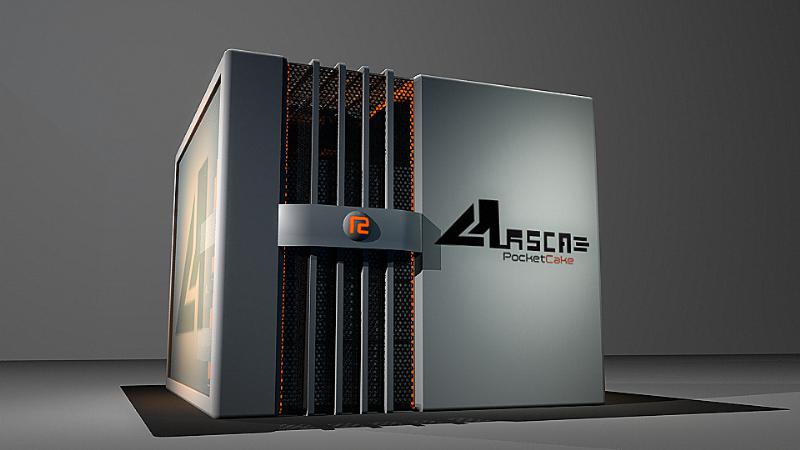A new product from PocketCake, called VRSCA (for Virtual Reality Simulation Converter Assembly), is three times more powerful than the average high-performance computer and allows for up to eight people to experience a virtual reality simulation at the same time.
VR enables users to experience immersive, computer-generated 3D environments through the use of specialized headsets and state of the art modeling software. Since the price of VR headsets and software has dropped significantly in recent years, developers are limited only by their imaginations and processing efficiency.
PocketCake is releasing a new product, the VRSCA (for Virtual Reality Simulation Converter Assembly), to remove the limits on processing power and setting developers' imaginations free.
Most computers are not equipped to handle the massive volume of data contained in a typical VR simulation file. A high performance laptop computer can process the data necessary to simulate a 25,000 square-foot building at a frequency of 25 frames per second.
By contrast, VRSCA processes the same model at 80 frames per second. A 100,000-square-foot model with defined interior and dynamic lighting would crash the average high-powered computer. VRSCA, on the other hand, runs the simulation with ease: no lag; no overheating.
VRSCA allows for up to eight people, wearing headsets such as the Oculus Rift, to experience a virtual reality simulation in the same room at the same time.
Virtual reality simulations for multiple viewers
VRSCA is available in four models: a single viewer, a dual viewer, a 4-person viewer and an 8-person viewer. The single, dual and 4-person viewers are portable. Each VRSCA is capable of hosting as many as 58 viewers remotely. This means simulations can be viewed simultaneously by 58 viewers in different locations.
VRSCA can be equipped with options such as a controller that allows for easy navigation through a simulation and the ability to change spawn points and control lighting.
Stanford graduate and hardware engineering manager for QuEST Rail, Matt Rogge PhD, EE is overseeing design and production of VRSCA. Dr. Rogge's knowledge and experience in railroad control electronics and digital systems provides a key element to the VRSCA project's success.
For more information, visit: www.pocketcake.com/vr.html.
Related Stories
| Oct 17, 2011
Aerialogics announces technology partnership with CertainTeed Corp.
CertainTeed to provide Aerialogics’ Aerial Measurement Services to its credentialed contractor base and utilize the technology in its Roofing Products Division.
| Oct 17, 2011
Big D Floor covering supplies to offer Johnsonite Products??
Strategic partnership expands offering to south and west coast customers.
| Oct 17, 2011
Clery Act report reveals community colleges lacking integrated mass notification systems
“Detailed Analysis of U.S. College and University Annual Clery Act Reports” study now available.
| Oct 17, 2011
USGBC L.A. Chapter's Green Gala to feature Jason McLennan as keynote speaker
Chapter to presents inaugural Sustainable Innovation Awards,
| Oct 17, 2011
Schneider Electric introduces UL924 emergency lighting control devices
The emergency lighting control devices require fewer maintenance costs and testing requirements than backup batteries because they comply with the UL924 standard, reducing installation time.
| Oct 14, 2011
AISC develops new interoperability strategy to move construction industry forward
AISC is working to bring that vision to reality by developing a three-step interoperability strategy to evaluate data exchanges and integrate structural steel information into buildingSMART's Industry Foundation Classes.
| Oct 14, 2011
University of New Mexico Science & Math Learning Center attains LEED for Schools Gold
Van H. Gilbert architects enhances sustainability credentials.
| Oct 14, 2011
BD+C Survey on Building Information Modeling: The Good, the Bad, and the Solutions
In a recent survey conducted by Building Design+Construction, more than 75% of respondents indicated they currently use BIM or plan to use it. Respondents were also asked to comment on their experiences with BIM, what they liked and disliked about BIM, and what BIM-related advice they would give to their peers.
| Oct 14, 2011
ACI partners with CRSI to launch new adhesive anchor certification program
Adhesive anchor installer certification required in new ACI 318-11.
| Oct 14, 2011
Midwest construction firms merge as Black and Dew
Merger is aimed at increasing market sector capabilities and building on communication and core contracting competencies.
















